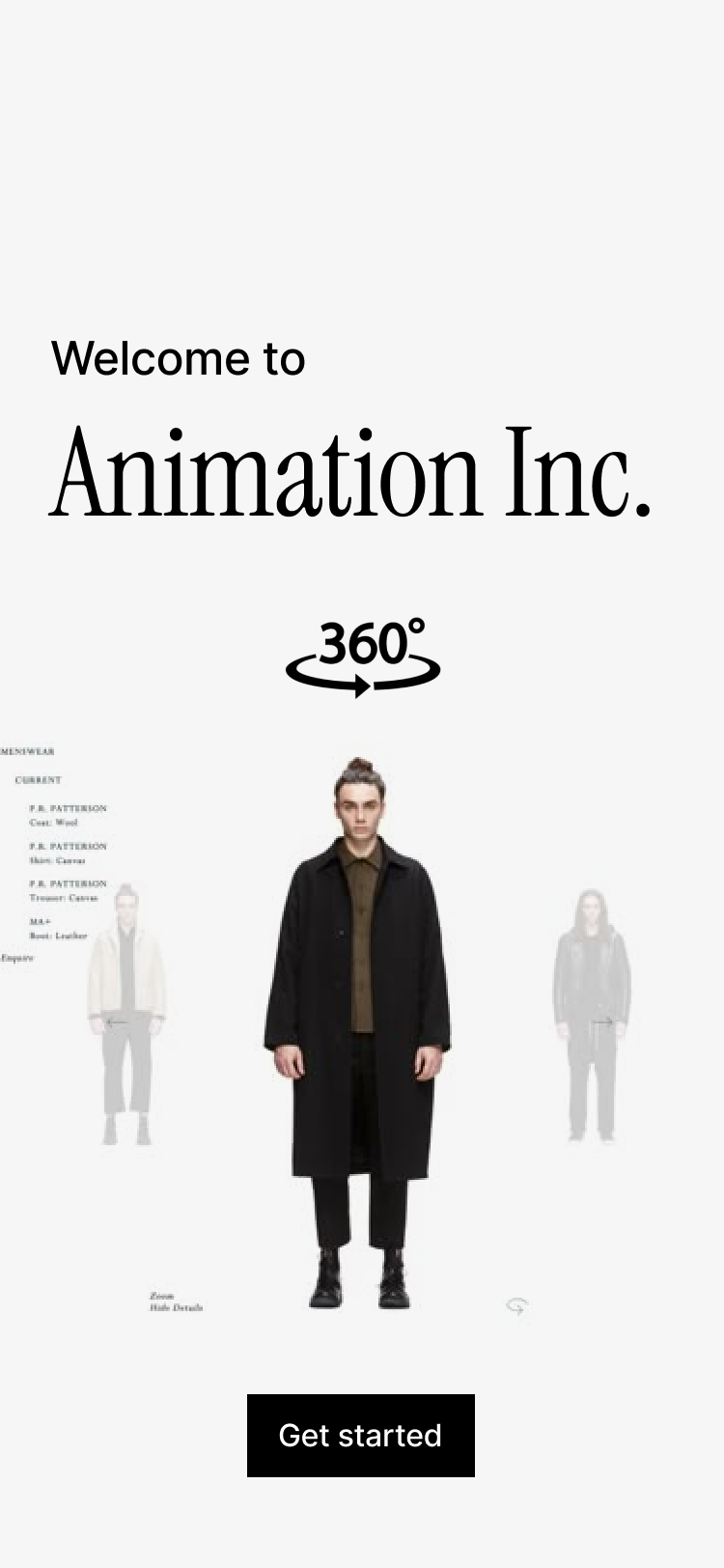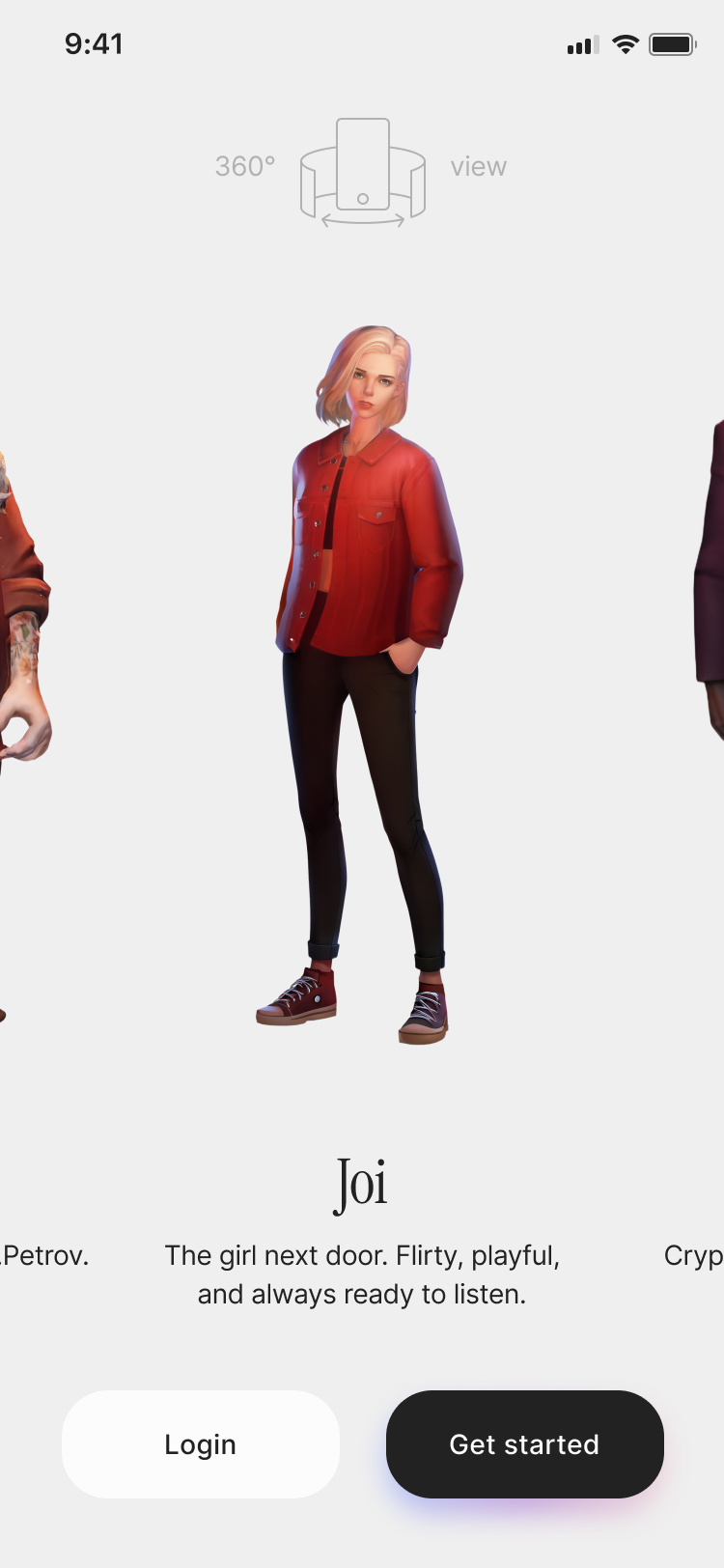Animation Inc.
Real-Time AI Animation App
2025
Situation
Animation Inc. is a deeptech startup developing a real-time generative animation model required a native app to onboard users and demonstrate the potential of their technology. The goal was to communicate the product’s value through intuitive onboarding and a variety of practical use cases.
Task
The objective was to deliver a scalable, testable app concept that would support smooth onboarding and allow users to explore the model’s AI-powered features. The solution needed to be validated, ready for development, and aligned with long-term product strategy.
Action
A structured product design workflow was applied, starting with UX research to identify key opportunities and user needs. Insights were translated into a functional concept through iterative validation — progressing from early sketches to a development-ready interface. The process focused on speed, clarity, and scalability.
Result
Within 40 hours, a validated proof of concept was delivered, achieving a usability score of 10/10 in initial testing. The concept served as a foundation for future product decisions and helped define a clear approach to user onboarding and client engagement.
Animation Inc. is a deeptech startup developing a real-time generative animation model required a native app to onboard users and demonstrate the potential of their technology. The goal was to communicate the product’s value through intuitive onboarding and a variety of practical use cases.
Task
The objective was to deliver a scalable, testable app concept that would support smooth onboarding and allow users to explore the model’s AI-powered features. The solution needed to be validated, ready for development, and aligned with long-term product strategy.
Action
A structured product design workflow was applied, starting with UX research to identify key opportunities and user needs. Insights were translated into a functional concept through iterative validation — progressing from early sketches to a development-ready interface. The process focused on speed, clarity, and scalability.
Result
Within 40 hours, a validated proof of concept was delivered, achieving a usability score of 10/10 in initial testing. The concept served as a foundation for future product decisions and helped define a clear approach to user onboarding and client engagement.
Overview
Animation Inc., a deeptech startup working at the intersection of AI and 3D animation, set out to build a real-time generative animation model capable of creating responsive, expressive characters directly on-device. While the technology itself was groundbreaking, it needed a tangible product to showcase its full potential — something users could explore, test, and engage with.
The vision was to create a native app that would serve both as an onboarding platform and a discovery space, allowing users to experience the AI model firsthand. The challenge was not only to make the advanced technology accessible, but to do so in a way that felt seamless, intuitive, and scalable.
The vision was to create a native app that would serve both as an onboarding platform and a discovery space, allowing users to experience the AI model firsthand. The challenge was not only to make the advanced technology accessible, but to do so in a way that felt seamless, intuitive, and scalable.
Discover
The process began with rapid yet focused UX research to uncover the needs of potential users and understand the context in which the product would exist. Given the novelty of the technology, it was important to look at comparable tools in the AI, 3D, and character design spaces to understand user expectations and gaps in the market.
This stage included:
Competitive analysis was paired with user interviews and behavioral research around onboarding friction, content creation workflows, and expectations from AI-powered systems. Several opportunity areas emerged:
This stage included:
- Stakeholder interviews to align on product vision, technical constraints, and success metrics.
- Benchmarking of competitors and references from adjacent industries (AI chat, avatar creation, real-time rendering tools).
- User group creation to segment different types of target users such as creators, developers, early adopters, and casual explorers.
- User interviews to validate assumptions, uncover motivations, and gather insights on desired features and interaction styles.
Competitive analysis was paired with user interviews and behavioral research around onboarding friction, content creation workflows, and expectations from AI-powered systems. Several opportunity areas emerged:
- Users wanted quick and playful ways to test the product before investing time in setup.
- Clear use cases (like chatting with AI characters or creating avatars) made the product's value easier to grasp.
- Onboarding had to feel lightweight and story-driven, not technical or overwhelming.
Define
With early insights in hand, the next step was to define the product structure and core experience principles. A clear objective was established: reduce cognitive load and maximize the sense of immediacy.
A user journey was mapped out from first interaction to repeat usage. Key moments were defined, such as:
Personas were created to represent early adopters — creative technologists, developers, and curious users looking for entertainment and experimentation. These personas helped frame the app as not just a tool, but a portal into interactive, generative storytelling.
An added challenge in this phase was to combine emerging AI-driven UX opportunities with well-established patterns that users might already be familiar with — especially during the AI avatar creation flow, where innovation needed to be balanced with familiarity to avoid alienating new users.
Additionally, a dedicated Tone of Voice exploration was conducted to ensure the interface reflected the futuristic and experimental nature of the app. This tone was applied consistently across onboarding flows, UI copy, and interaction prompts to reinforce the app’s identity and evoke curiosity.
A user journey was mapped out from first interaction to repeat usage. Key moments were defined, such as:
- Landing in the app with minimal friction
- Instantly interacting with AI-generated content
- Personalizing the experience through character creation
- Understanding how the animation model works through doing, not reading
Personas were created to represent early adopters — creative technologists, developers, and curious users looking for entertainment and experimentation. These personas helped frame the app as not just a tool, but a portal into interactive, generative storytelling.
An added challenge in this phase was to combine emerging AI-driven UX opportunities with well-established patterns that users might already be familiar with — especially during the AI avatar creation flow, where innovation needed to be balanced with familiarity to avoid alienating new users.
Additionally, a dedicated Tone of Voice exploration was conducted to ensure the interface reflected the futuristic and experimental nature of the app. This tone was applied consistently across onboarding flows, UI copy, and interaction prompts to reinforce the app’s identity and evoke curiosity.
Design
A modular product design system was established to allow for rapid iteration while keeping the UI scalable. Wireframes were developed to define the structure, followed by mid-fidelity mockups that integrated brand elements and personality.
The design focused on four key areas:
Attention was paid to tone of voice, animation microinteractions, and a sense of agency. Users needed to feel like they were co-creating, not just tapping buttons.
The design focused on four key areas:
- Onboarding. A conversational, low-friction flow introducing users to their AI twin and how to begin exploring.
- AI Chat. A core experience where users interact with both discovered AI characters and ones they’ve created themselves.
- Avatar Creation. Tools for building and customizing AI twins, with voice, style, and personality.
- Use Case Exploration. Suggested interactions and character archetypes to guide discovery and experimentation.
Attention was paid to tone of voice, animation microinteractions, and a sense of agency. Users needed to feel like they were co-creating, not just tapping buttons.




Deliver
Within 40 hours, the concept moved from rough idea to a validated, clickable prototype. The workflow included:
The prototype was put in front of early users and stakeholders, receiving immediate positive feedback. Testing focused on comprehension, engagement, and perceived value. A usability score of 10/10 was achieved based on a simple, scenario-driven task evaluation. Participants found the app clear, inviting, and exciting to explore.
- User flow mapping
- Wireframe iterations and design sprints
- UI system setup (typography, color, components)
- Interactive prototype for user testing
- Design system development, including primitives, reusable components, and states
- Implementation of both Dark and Bright UI themes to accommodate different contexts and user preferences
The prototype was put in front of early users and stakeholders, receiving immediate positive feedback. Testing focused on comprehension, engagement, and perceived value. A usability score of 10/10 was achieved based on a simple, scenario-driven task evaluation. Participants found the app clear, inviting, and exciting to explore.






Results and Impact
- 0 → Validated PoC in under 40 hours
- 10/10 usability score from test participants
- Enabled internal alignment across product, engineering, and business teams
- Facilitated client onboarding with a live demo artifact
- Informed the long-term product roadmap and strategic positioning
- Sparked conversations with external partners about content creation, education, and entertainment use cases
- Demonstrated ability to deliver high-impact design quickly in a fast-paced deeptech environment
The completed proof of concept helped Animation Inc. quickly align internal teams and external partners around a shared product vision. It served as a demoable artifact that communicated the potential of the AI model far more effectively than static documents or pitch decks.
Findings and Learnings
- Narrative onboarding outperforms technical walkthroughs when introducing emerging technologies.
- Letting users play first and learn later increases engagement and perceived value.
- Modularity in design enables quicker pivots and better stakeholder collaboration.
- Even in deeptech, emotion and character design can be key to user adoption.
- Fast, focused prototyping is a powerful way to validate direction before writing a single line of code.
- Balancing innovation with familiarity is essential when designing for AI-driven user experiences.
This project showed that even the most advanced AI models benefit from thoughtful, human-centered product design — not just to explain what the technology does, but to show users why it matters.
Thank you